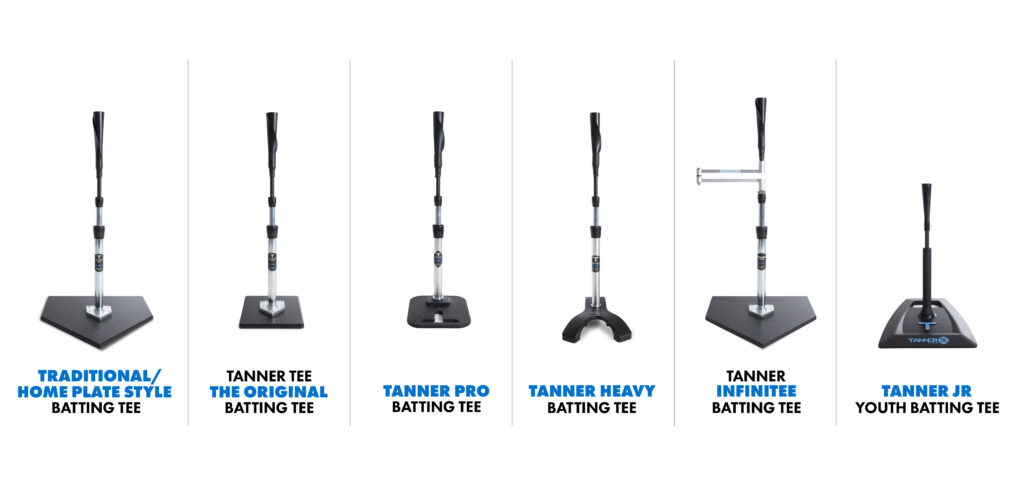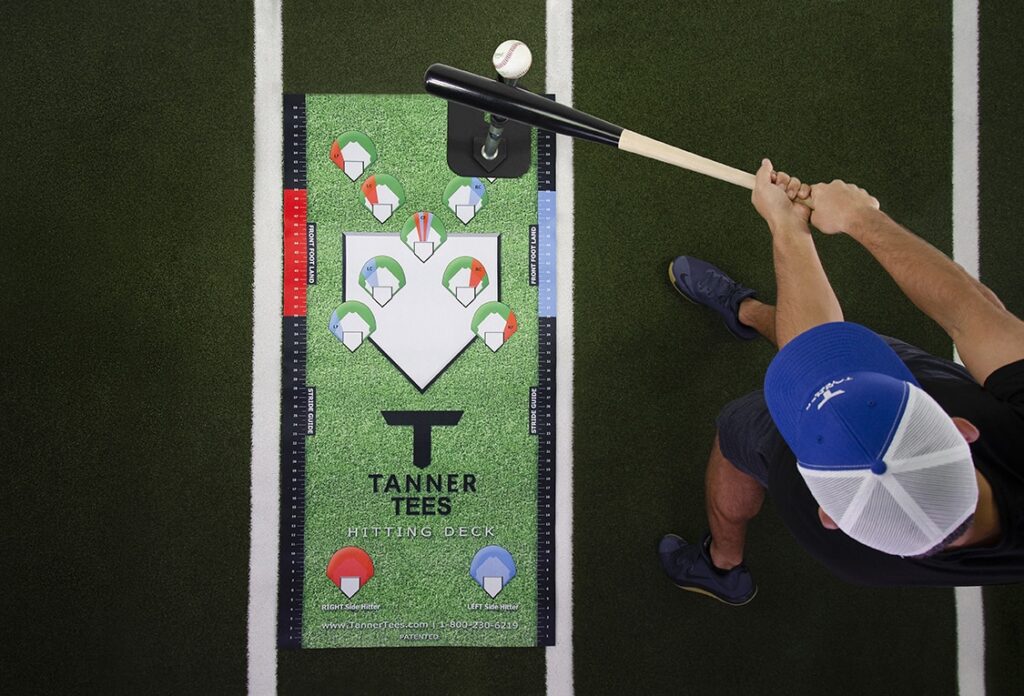Search Articles
How to Hit Farther in Baseball

Est. Reading:
7 min
Updated: October 20, 2023
Article Contents
Summary
- Hitting off a batting tee is one of the best ways to improve your swing and isolate specific hitting goals.
- A batting tee is a hitting tool used to practice your swing - with a coach or without a coach, almost anywhere with no need for live pitchers.
- Everyone wants to hit for distance, and the game requires that everyone can hit for distance in certain circumstances. Hitting home runs earns you playing time at every level.
- How to hit farther in baseball requires a strong swing with high bat speed, a good stance that transfers energy through the body in the right sequence, and a strong understanding of the mechanics behind solid hitting.
Hitting Your First Home Run
Remember the day you hit your first home run in baseball? It was the day you realized you could do anything! The big leagues were just a few thousand travel ball miles away. If we could just hit .330 and 25 home runs every season, we'd have a shot at The Show.
So what does it take to hit home runs, and, moreover, should we be coaching hitters to hit more home runs? Or should hitting practice and the mental approach to hitting focus on powerful, good swings that will ultimately lead to home runs?
Yes. Both. Depends on the individual. Depends on the team makeup. It depends.
We'd never tell a hitter to not practice to hit the ball as far as they are capable of hitting it. Isn't this the same thing as working on hitting a home run? Look at the best players in the game who have the highest salaries and best stats. Josh Donaldson repeatedly says he tries to get the ball in the air to maximize the distance and yes hit more home runs.
Even second basemen are hitting home runs. It's just the way the game is heading. Is it the right direction? Is it the purest form of the game? Possibly. Baseball is cyclical. Right now we have power pitchers and power hitters.
Perhaps the gritty Tampa Rays play baseball the way it's meant to be played, and maybe that's better than a long ball team. Nonetheless, whatever side you land on, home runs are celebrated, and hitting home runs earns playing time at every level.
In this article, we will take a deeper dive into the key components of hitting home runs, as well as introduce some tools to help you train.
Using a Batting Tee for Hitting Harder and Farther

We would never tell a hitter to only practice for hitting home runs, or to make hitting home runs the only thing that matters at the plate. Balanced, effective hitters should be able to move a runner with a long fly ball, drive the baseball to the right side of the field when needed, and hit for power too. Whatever the team needs, he or she should be equipped to provide.
Before you can hit home runs and do it more often, there are many variables that must align at the plate - bat speed, stance, strength, launch angle, timing, and sequence will all help you to hit the ball farther.
Training with a Tanner batting tee is one of the most effective tools to practice hitting.
What is a Batting Tee?
A batting tee is a hitting aid, or hitting tool, used to practice your baseball swing, without the need of a pitcher. Placing a ball on its rubber cone, players can raise the tee higher or lower and move it in and out to cover every pitch location they may face in a game.
Of course, hitting off a batting tee does NOT replace live batting practice. Tee training should be a part of your hitting practice that combines with flips, front toss, machine work with different speeds and spins, and of course, live pitching.
There is great value in placing the baseball at the height you want, in the location you want, and then working your swing angle how you want to drive the baseball at a target you predetermine like the back of the cage or the top of the cage.
A tee helps control the variability of hitting live pitching or off a machine. It is not always easy for coaches or a pitching machine to throw the baseball exactly where a certain hitting drill requires it to be. A batting tee removes the error and gives hitters the opportunity to isolate a specific thing.
Hitting for Distance
Hitting a home run involves hitting for distance. How you hit for distance involves the obvious: Strength - how strong you are and how much bat speed can you generate. But there's more to consider, and there are tools nowadays to observe them:
- bat angle at contact (launch angle)
- pitch speed
- contact point on the baseball or softball
- exit velocity
- bat speed
- energy transfer through the stance to contact
- energy transfer as it relates to timing and sequencing
- swing path
Many of the factors listed above can be trained on a Tanner batting tee. For instance, put the batting tee at a certain height, in a specific location in relation to feet and home plate (position of contact) and aim for a specific spot on the baseball. If you can measure accurately where you contacted the baseball (may require a camera or other data device), you'll observe that small changes in bat angle or the position of contact cause the baseball to travel faster or slower, farther or shorter.
If you have access to a data device like a Blast Motion Bat Sensor, you are now gathering insight into your specific hitting mechanics that can be used for creating programs designed for you. The tee helps do these types of things, and hitting off a tee is certainly used at the professional level. It's not the only batting practice professionals do nor should it be for you, but it's part of the complete hitting package.
Strengthen Your Batting Swing
The key to a powerful batting swing isn't just strong muscles, but it is also strong muscles! To increase your bat speed/exit velocity, you need to hit the gym. The hallmarks of strength training like deadlifts and squats, under professional guidance of course, should be a part of your lifting programs. Hitting with a overload or underload bat, using weighted balls and resistance bands are also ways to increase the fast-twitch muscle fibers used in the baseball swing.
It's also important to understand the "kinetic chain" and how your body parts work together in a specific sequence to create movement. Here's a link to a blog where we talk about that concept further:
Developing a Solid Batting Stance

A good batting stance is the foundation of a powerful hitting, and a good stance can be achieved in a number of ways. Take a look at ten professional players. You'll see ten different stances, but the hallmarks of powerful hitting are evident in all ten hitters.
A good batting stance will allow for a fierce transfer of energy to occur. It's an explosive, almost violent harmony of muscles and bones working together to generate a movement of energy that ultimately (and hopefully) transfers as much energy as possible into the bat-ball connection.
To an eight year old, it may be best to explain it by "shifting their weight" or "rotating" or "spinning." For a high schooler and up, the physics of the swing are relevant and should be taught.
Stances that get too far out on a front foot are often considered weaker hitting positions at the younger level. But, be forewarned this consideration is not an absolute truth. There are plenty of pros that rotate their backside against a stiff front leg to generate power. Sometimes the back foot up even comes up at contact. Other hitters simply spin and rotate; no step, no feet coming up.
So, again, there is no ONE way to achieve a powerful swing. What both of these stances never do, however, is become disconnected at the hips and arms. The arms always stay in tight to the body and are supported kinesthetically by the hips, core and legs. Conversely, casted arms that become disconnected lead to weaker batted balls.
The Tanner Hitting Deck

For a newer hitter, to help explain batting stance in relation to contact point, we have a baseball hitting aid called the Tanner Hitting Deck - a visual teaching tool that features a "Stride Guide", allowing hitters to always line up consistently and make contact in the correct position to drive the baseball or softball to the desired area of the field.
The Hitting Deck teaches them that their feet should be in the same positions regardless of pitch locations and regardless of their preferred stance. Whether they are a no stride, open or closed stance hitter, they remain consistent. What does change is the position of contact - where in their stance the contact occurs.
Train Hard, Train Often.
At Tanner Tees, it is our mission is to help you at every step of your baseball or softball journey - regardless of skill level. If you are serious about hitting farther, understanding how to get more bat speed, strength and maximize your stance, along with hard work will help to get you there. The staff at Tanner Tees is always here to answer any questions you might have. Give us a call (800-230-6219) or visit our Facebook and Instagram pages to connect with other members of our community!


